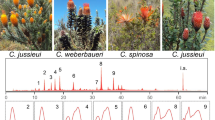Abstract
Centella asiatica (L.) Urban is a widely distributed herbaceous plant with great medicinal value that has been extensively used in traditional Chinese medicine. For effective quality control of C. asiatica, a feasible approach and control system is necessary. In this paper, a chemical fingerprint method (column liquid chromatography) was developed for investigating and demonstrating the variance of chemical components among different populations of C. asiatica, from 14 locations in China. The LC data showed considerable variation of chemical constituents among C. asiatica populations. Four chemotypes were visually developed from the chromatographic profiles. The hierarchical clustering analysis further suggested that the samples were divided into four major groups. The grouping of 14 C. asiatica populations in hierarchical clustering analysis was in good agreement with the visual comparison of their chromatograms, as demonstrated by chemotypes. In addition, the bioactive compound asiaticoside in this herb was quantitatively determined by a validated reversed-phase liquid chromatography analysis. Chemotype I was identified as asiaticoside-rich chemotype and exhibited significantly higher amounts of asiaticoside. These findings and results provide a solid basis to establish good agriculture practice and select geo-authentic crude drug for C. asiatica. The established method was considered to be suitable for fingerprint analysis for the quality control of C. asiatica.



Similar content being viewed by others
References
Normile D (2003) Science 299:188–190
Eisenberg DM, Davis RB, Ettner SL, Appel S, Wilkey S, Van Rompay M, Kessler RC (1998) JAMA 280:1569–1575
Chevallier A, Namba T (2000) The encyclopedia of medicinal plants. Seibundo Shinkosha Publishing Co. Ltd, China, p 74
Joshi SG (2000) Medicinal plants. Oxford & IBH Publishing Co. Pvt Ltd, New Delhi, p 31
Gupta R, Flora SJS (2006) J Appl Toxicol 26:213–222
Punuree K, Wild CP, Kasinrerk W, Vinitketkumnuen U (2005) Asian Pac J Cancer Prev 6:396–400
Subban R, Veerakumar A, Manimaran R, Hashim KM, Balachandran I (2008) J Nat Med 62:369–373
Yoshida M, Fuchigami M, Nagao T, Okabe H, Matsunaga K, Takata J, Karube Y, Tsuchihashi R, Kinjo J, Mihashi K, Fujioka T (2005) Biol Pharm Bull 28(1):173–175
Park BC, Bosire KO, Lee ES, Lee YS, Kim JA (2005) Cancer Lett 218:81–90
European Pharmacopoeia (2002) 4th edn
Sampson JH, Raman A, Karlsen G, Navsaria H, Leigh IM (2001) Phytomedicine 8(3):230–235
Shukla A, Rasik AM, Dhawan DN (1999) Phytother Res 13:50–54
Lu L, Ying K, Wei SM, Fang Y, Liu YL, Lin HF, Ma L, Mao YM (2004) Int J Dermatol 43:801–807
Das A, Mallick R (1991) Bot Bull Acad Sin 32:1–8
Randriamampionona D, Diallo B, Rakotoniriana F, Rabemanantsoa C, Cheuk K, Corbisier AM, Mahillon J, Ratsimamanga S, Jaziri ME (2007) Fitoterapia 78:482–489
WHO (2000) General guidelines for methodologies on research and evaluation of traditional medicine. WHO, Geneva, p 1
FDA (2000) Guidance for industry-botanical drug products (draft guidance) FDA, Washington, DC, I, B, 2e; 3e
EMA (2001) Note for guidance on quality of herbal medicinal products European Medicines Agency, London, p 6
SFDA. State Drug Administration of China (2000) Requirements for studying fingerprint of traditional Chinese medicine injection (Draft). Chin Tradition Patent Med 22:671–675
Liang YZ, Xie P, Chan K (2004) J Chromatogr B 812:53–70
Schaneberg BT, Mikell JR, Bedir E, Khan IA (2003) Pharmazie 58:381–384
Pan J, Kai GQ, Yuan CX, Zhou BB, Jin RS, Yuan Y (2007) Chin J Chromatogr 25(3):316–318
Acknowledgments
This work was supported by the National Natural Science Foundation of China (no. 30572327). We thank Dr. C. J. Zheng, School of Pharmacy, Second Military Medical University, China, for technical assistance.
Author information
Authors and Affiliations
Corresponding author
Additional information
Xiao-Gang Zhang and Ting Han have contributed equally to this work.
Rights and permissions
About this article
Cite this article
Zhang, XG., Han, T., Zhang, QY. et al. Chemical Fingerprinting and Hierarchical Clustering Analysis of Centella asiatica from Different Locations in China. Chroma 69, 51–57 (2009). https://doi.org/10.1365/s10337-008-0851-8
Received:
Revised:
Accepted:
Published:
Issue Date:
DOI: https://doi.org/10.1365/s10337-008-0851-8




